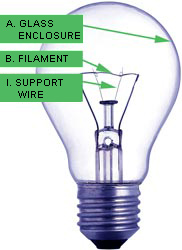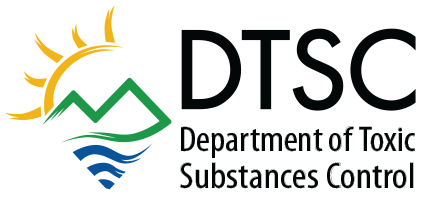Lighting FAQs
When testing incandescent light bulbs for lead, what parts would be considered a “homogenous material”?
 “Homogeneous material” is defined in RoHS Directive guidance documents as “a material that cannot be mechanically disjointed into different materials.” There are many “homogenous materials” that make up an incandescent light bulb. These may include the bulb (the glass enclosure) (A), the filament (B) which may be a straight wire or a coil made of tungsten, a support wire (I), etc. Each of these would need to meet the requirements for lead set forth in the EU RoHS Directive (< 0.1% lead by weight).
“Homogeneous material” is defined in RoHS Directive guidance documents as “a material that cannot be mechanically disjointed into different materials.” There are many “homogenous materials” that make up an incandescent light bulb. These may include the bulb (the glass enclosure) (A), the filament (B) which may be a straight wire or a coil made of tungsten, a support wire (I), etc. Each of these would need to meet the requirements for lead set forth in the EU RoHS Directive (< 0.1% lead by weight).
As a manufacturer am I required to provide certification to a seller for my “general purpose lights” sold in California?
The law requires manufacturers of general purpose lights that are sold or offered for sale in California to provide, upon request, certification to sellers of those general purpose lights, that the lights are compliant with the RoHS Directive (Health & Saf. Code, § 25210.9, subd. (h).). A manufacturer may comply with this requirement by displaying the certification on the shipping container or packaging of general purpose lights.
As a manufacturer, am I required to submit documentation to DTSC for my “general purpose lights” sold in California?
The law requires manufacturers of general purpose lights that are sold or offered for sale in California to prepare technical documentation or other information showing that the lights comply with the requirements of the RoHS Directive (Health & Saf. Code, § 25210.9, subd. (h).). However, this documentation must only be provided to DTSC upon request, within 28 days of the date of the request (Health & Saf. Code, § 25210.9, subd. (h).). DTSC encourages manufacturers to have technical documentation readily available for all “general purpose lights” determined to be subject to the RoHS requirements in order to respond to any DTSC request in a timely manner.
Are there any exemptions that allow lead in light bulbs?
The RoHS Directive exempts certain applications of lead, which may be applicable to the construction of light bulbs. One exemption is for “lead used in high melting temperature type solders”. For incandescent bulbs, an electrical contact is made by soldering one lead-in wire to the center contact in the base of the bulb and the other is soldered to the upper rim of the base shell. If the solder used for this purpose meets the criteria for “high melting temperature type solder,” it may be exempt from RoHS’s lead restrictions under RoHS exemption – Application 7.
Another exemption, RoHS exemption – Application 6, allows the concentration of lead used as an alloying element in steel, aluminum and copper alloy to exceed 0.1 percent lead by weight. For steel, the maximum concentration value (MCV) is 0.35 percent by weight; for aluminum the MCV is 0.4 percent by weight; and for copper alloy, the MCV can be up to 4 percent by weight.
For further guidance please refer to the DTSC flow chart for incandescent lamps.
Are luminaries considered a “general purpose light” as that term is defined in Health and Safety Code section 25210.10?
A luminaire may or may not be a general purpose light. General purpose lights are defined in the Health and Safety Code as: “lamps, bulbs, tubes, or other electric devices that provide functional illumination for indoor residential, indoor commercial, and outdoor use.” (Health & Saf. Code § 25210.10.) Health and Safety Code Section 25210.10 is silent as to whether “luminaires” would be considered a general purpose light.
There are many different types of luminaires. Research indicates that the term “luminaire” is generally used to refer to a light fixture, a light unit, or in some cases the entire body of a freestanding lamp. Various regulatory agencies, including the California Energy Commission, define “luminaire” as “the complete lighting unit, consisting of fluorescent lamp or lamps, together with parts designed to distribute the light, to position and protect such lamps and to connect such lamps to the power supply through the ballast.” In some cases, a luminaire may include a lamp, bulb or tube. Because there are many different types of luminaires, a determination of whether or not a specific luminaire is a general purpose light needs to be made on a case-by-case basis.
Is a ballast considered a part of a general purpose light as that term is defined in Health and Safety Code section 25210.10?
A ballast may or may not be part of a “general purpose light.” Statute defines the term general purpose lights to mean: “lamps, bulbs, tubes, or other electric devices that provide functional illumination for indoor residential, indoor commercial and outdoor use” (Health & Saf. Code § 25210.10.). Section 25210.10 is silent as to whether a ballast would be considered a “general purpose light” for purposes of that section.
In response to a letter from Universal Lighting Technologies, DTSC considered the question of whether a separate ballast located inside a lighting device would constitute part of a “general purpose light” for purposes of Health and Safety Code section 25210.10. Based on the information submitted to DTSC, DTSC opined that ballasts that are not integrated into the lighting device or ballasts that are separately located from the general purpose lighting device would not be considered general purpose lights for purposes of Health and Safety Code section 25210.10. In contrast, ballasts (or similar component such as an LED driver) that are integrated into the discrete component of the light, such as a screw-in compact fluorescent lamp, would be considered a general purpose light and the RoHS requirements would apply to the entire discrete component, including the ballast.
Are light bulbs in toys and other devices that contain small discrete lighting considered general purpose lights as that term is defined in Health and Safety Code section 25210.10?
Statute defines the term “general purpose lights” to mean: “lamps, bulbs, tubes, or other electric devices that provide functional illumination for indoor residential, indoor commercial, and outdoor use” (Health & Saf. Code § 25210.10). Generally light bulbs in toys and other devices are not intended to provide “functional illumination for indoor or commercial use or outdoor use” and are therefore not considered “general purpose lights” as defined in Health and Safety Code section 25210.10.
I have read the RoHS Directive and I noticed it references the WEEE Directive. How do these two directives relate to one another?
The RoHS Directive incorporates the definition of “electrical and electronic equipment”(EEE) (which includes “lighting equipment”) from the Waste Electrical and Electronic Equipment (WEEE) Directive (EU Directive 2002/96/EC). The WEEE Directive is a European Union law designed to promote the recycling of EEE by making manufacturers responsible for the products they make when they are no longer needed. WEEE specifically lists the following examples of lighting equipment:
- Luminaries for fluorescent lamps with the exception of luminaries in households;
- Straight fluorescent lamps;
- Compact fluorescent lamps;
- High intensity discharge lamps, including pressure sodium lamps and metal halide lamps;
- Low pressure sodium lamps; and
- Other lighting or equipment for the purpose of spreading or controlling light with the exception of filament bulbs.
In addition to the above specific examples, the RoHS Directive also applies to electric light bulbs and luminaires in households.
Within the RoHS Directive is a list of exemptions for certain uses of the hazardous substances covered by the directive – lead, mercury, cadmium, hexavalent chromium, polybrominated biphenyls (PBBs) and polybrominated diphenyl ethers (PBDEs). When determining if an exemption applies to a specific product, please read the exemption carefully as most of the exemptions apply only to very specific applications of one of the hazardous substances covered by the directive.
As a retailer, after January 1, 2010, can I still sell my existing stock of lighting even though those lights may not comply with AB 1109 restrictions?
Yes. All lights, including general purpose lights, manufactured prior to January 1, 2010 can be sold or offered for sale by a retailer after January 1, 2010. However, all general purpose lights purchased by retailers from manufacturers and distributors after January 1, 2010 that fall within the scope of AB 1109 must comply with all applicable restrictions unless the retailer can show the general purpose lights were manufactured prior to January 1, 2010.
Lighting Links
Toxics in Products Links
- Toxics in Products Home
- Cadmium in Jewelry
- Lead and Arsenic in Glass Beads
- Lead in Jewelry
- Lead in Plumbing
- Mercury Reduction in Products & Devices
- Recycling Mercury Thermostats
- Restrictions on the use of Certain Hazardous Substances (RoHS) in Electronic Devices
- Toxics in Packaging
- Toxics Reduction in Lighting
- Treated Wood Waste
Hazardous Waste Links
- Hazardous Waste Home
- Certified Appliance Recycler (CAR) Program
- CUPAs
- Defining Hazardous Waste
- Electronic Waste (E-Waste)
- Emergency Response Program
- Enforcement
- Facilities (TSDFs)
- Generator Improvements Rule
- Generators
- Hazardous Waste ID Numbers
- Hazardous Waste Management Plan
- Hazardous Waste Manifests
- Hazardous Waste Tracking System
- Household Hazardous Waste
- Metal Recycling
- Metal Shredding Facilities and Wastes
- Permitting
- Toxics in Products
- Transporters
- Universal Waste
- Form 1358
- California Hazardous Waste Codes

